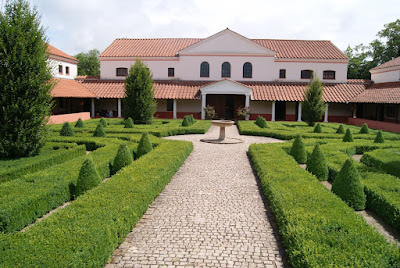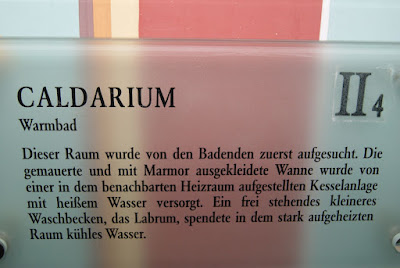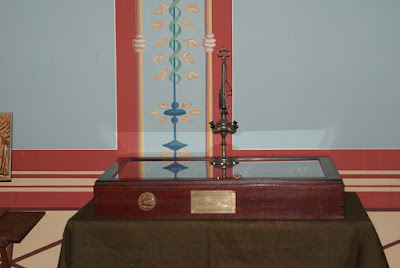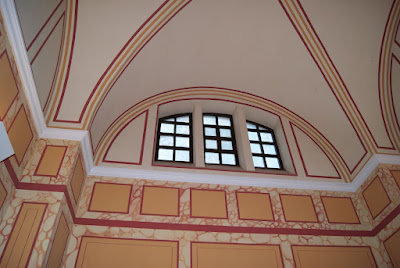Erst vor ein paar Tagen wurde mir die nachfolgende Karikatur auf Facebook angezeigt.
Oh wie wahr, kann ich da nur laut und weinend ausrufen.
Wie wahr!!!
Eine der größten Tragödien der Menschheitsgeschichte ist definitiv der Untergang des Römischen Reiches.
Über die Gründe gibt es unzählige Erklärungen, Interpretationen, Mutmaßungen.
Wichtig sind die Ergebnisse für Europa.
Und diese Ergebnisse sind erschütternd.
Hier in meiner Region Deutschlands, die zum Römischen Reich gehörte, bedeutete dieser Untergang der Wegfall von Wasserklosetts, Fußbodenheizungen, Mosaiken, Aquädukten, Bäderanlagen … und, und, und.
Was bekamen wir???
Strohgedeckte Lehmbuden, die Mensch und Vieh gleichermaßen und nur dürftig voneinander getrennt zusammenführten.
Eine wirklich tolle Wohngemeinschaft, die in manchen Gegenden Deutschlands tatsächlich noch fast 2000 Jahre aufrechterhalten wurde (geben Sie mal in Wikipedia den Begriff Hallenhaus ein).
Hinzu kam noch, dass die Buden dann auch ziemlich oft verraucht waren, weil ja offene Feuerstellen, die durchdachten Küchenräume der Römer abgelöst hatten.
Ich schreibe jetzt mal nichts über Verwaltungsstrukturen, Bürokratie, öffentliche Ämter, Medizin, Militär und, und, und.
Nein.
Wir bleiben bei den Buden.
Waren Sie mal in einer Rekonstruktion gallischer, germanischer oder slawischer Dörfer, ja Burganlagen???
Ich habe mir da schon einige angeschaut.
Na und, was soll ich sagen.
Es ist gruselig.
Einfach gruselig.
Bist Du da stolz drauf, wenn Du das siehst?
Findest Du das wirklich spannend und innovativ??
Bereichert Dich das in Deinem Leben???
Wenn ja, dann Gratulation.
Mich enttäuscht es!
Mich ödet es an!!
Mich würgt es!!!
Wir Besucher wandeln da durch den Rückschritt.
Wir bewundern eine negative Zeitenwende.
Es ist genauso, als wenn Menschen durch die Trümmer eines apokalyptischen Krieges wandeln und feststellen, dass es echt großartig ist, überlebt zu haben. Danach gehen sie wieder in ihren Survival Shelter aus Birkenstämmen, um dort mit dem einzigen, dem Dorf verbliebenen Feuerstein, ein Feuerchen anzufachen.
Sie gucken sich um, sehen Shelter aus Birkenstämmen an Shelter aus Birkenstämmen gereiht. In der Mitte ist ein etwas größerer Shelter aus Birkenstämmen, sozusagen das Versammlungshaus der Gemeinschaft. Na und zum Glück fließt am „Dorfrand“ ein kleiner Fluss, der halbwegs trinkbares Wasser liefert.
‚Ist doch eigentlich gar nicht so verkehrt, was wir hier wieder aufgebaut haben‘, denken dann diese Menschen.
Ja.
Das beschreibt das poströmische Europa.
Na und, das ist jetzt kein Klischee.
Schauen Sie sich bitte Rekonstruktionen eines germanischen Dorfes an.
Vielleicht bekommen Sie dann ja auch dieses „na ja“ Gefühl, dass mich da immer beschleicht.
Dieses Fremdschämen. Dieses „Sich klein fühlen“ gegenüber der römischen Zivilisation.
Ich würde ja sagen, vergessen Sie einfach einen solchen Besuch.
Es sei denn Sie sind ein Typ, der folkloristische Veranstaltungen liebt.
Generell möchte ich aber mal provokant die Frage stellen, was soll Ihnen das bringen.
Nun gut.
Wenn Sie in ihrem Garten einen Shelter bauen wollen… Ja dann. Dann ist das ok. Da bringt Ihnen eine Besichtigung vielleicht sogar etwas.
Gut.
Einen weiteren Grund sich germanische Lehmhütten anzuschauen, mag es auch noch geben.
Viele Menschen können mit römischen Ruinen nichts anfangen. Dort, wo diese Ruinen vorhanden sind, stehen oder liegen dann ja auch nur Reste und Bruchstücke herum. Da versagt dann schon mal die Vorstellungskraft.
Vielleicht ist für diesen Personenkreis sogar der Shelter aus Birkenstämmen greifbarer als das Forum Romanum.
Mag sein.
O.K. Diese Zielgruppe kann sich eine poströmische Rekonstruktion, sprich ein Germanendorf, gerne anschauen.
Aber wenn Sie sich wünschen etwas RICHTIGES, etwas IMPOSANTES, zu sehen, wenn Sie den Unterschied greifen und erleben wollen, den Unterschied zwischen dem Römischen Reich und diesem poströmischen Rückschritt, dann, ja dann fahren Sie bitte ins Saarland.
Ins Saarland?
Ja. Ins Saarland!
Verbinden Sie den Ausflug einfach mit einem Aufenthalt in Trier.
Da schauen Sie sich zunächst die Porta Nigra, den Dom, die Konstantinsbasilika und die Reste der Thermen und das Amphitheater an.
Danach fahren Sie aber nach Perl Borg.
Nie gehört?
Verstehe ich.
Ging mir lange, lange Jahre auch so.
Bis ich dann mal persönlich den „Archäologiepark römische Villa Borg“ vor ein paar Jahren entdeckte.
Ich sag’s Ihnen.
Das lohnt sich.
Das ist was Feines.
Eine rekonstruierte römische Landvilla.
KOMPLETT!!!!!!! Mit allem Pi Pa Poh.
Torhaus, Wohnräume, Stallungen, ein römisches Bad, eine römische Taverne, eine römische Küche, ein Garten, ein Teich.
Funktionsbereit. Anschaulich. Perfekt gemacht.
Das ist echt was anderes, verglichen mit Lehm beschmierten Weidenruten, also Germanenhäusern, die zwar historisch korrekt, aber sooooooooooooo langweilig sind.
Liebe Museen.
Ich verdamme da nicht die Rekonstruktionen, die Arbeit, die da reingesteckt wurde.
Alles richtig. Alles gut.
Mich schockiert halt nur die Geschichte!!!!!!!!
DIE HISTORIE an sich!!!!!!
Dieses, was kam nach Rom.
EBEN DAS!!!!!
Anstatt Villen, Lehmhütten.
LEHMHÜTTEN!!!!!!!
Nix Vae Victis.
Vae Victoris, sage ich da nur.
Die Sieger sind die Leidtragenden.
Hätten die Germanen sich ehrlich gemacht, dann hätten Sie das auch zugeben müssen.
Aber warum soll man denn die eigene Nichtkultur runterspielen.
Nö. Das passt schon. Die wird einfach überhöht. Man ist doch Sieger.
Wenn Sie, meine lieben Leser, aber römische Kultur sehen wollen, dann fahren sie bitte zur Villa Borg.
Schweifen Sie durch die Räumlichkeiten, genießen sie den römischen Mulsum, speisen Sie in der Taverne, die Ihnen römische Gerichte anbietet.
Schauen Sie sich das Privatbad der Villa an.
Erleben Sie die Normalität, manche nennen es Luxus, eines römischen Landgutes, und vergleichen Sie das mit dem germanischen Bauerndorf.
Sie werden den Kopf schütteln, wenn sie da waren.
Und ich denke, auch Sie, werden danach weinen, wenn sie mit ihren Kindern in ein germanisches Museumsdorf fahren.
Sie werden sich als Nachfolger der Germanen schämen, und Ihren Kindern sagen:
„Doch, doch. Das römische Reich war schon klasse.“
VILLA BORG – Archäologiepark | Römische Villa Borg (villa-borg.de)
Just a few days ago, the following cartoon was shown to
me on Facebook.
Oh how true, I can only exclaim loudly and while weeping.
How true!!!
One of the greatest tragedies in human history is definitely the fall of the Roman Empire.
There are countless explanations, interpretations and conjectures about the reasons.
The results for Europe are important.
And these results are staggering.
Here in my region of Germany, which belonged to the Roman Empire, this demise meant the disappearance of water closets, underfloor heating, mosaics, aqueducts, baths... and, and, and.
What did we get???
Thatched mud shacks that brought together people and cattle alike and only poorly separated from each other.
A really great residential community that was actually maintained in some areas of Germany for almost 2000 years (enter the term Hallenhaus in Wikipedia).
In addition, the stalls were often filled with smoke, because open fireplaces had replaced the well thought-out kitchens of the Romans.
I'm not going to write anything about administrative structures, bureaucracy, public offices, medicine, the military and, and, and.
No.
We'll stick to the booths.
Have you ever been to a reconstruction of Gallic, Germanic or Slavic villages or castles???
I've already looked at a few.
Well, what can I say.
Its scary.
Just creepy.
Are you proud of it when you see that?
Do you find this really exciting and innovative?
Does that enrich you in your life???
If yes, then congratulations.
It disappoints me!
I'm bored!!
It chokes me!!!
We visitors are walking backwards.
We admire a negative turning point.
It's like when people walk through the rubble of an apocalyptic war and realize how great it is to have survived. Then they go back to their survival shelter made of birch trunks to start a little fire with the only flint left in the village.
You look around, see birch log shelters lined up next to birch log shelters. In the middle is a slightly larger shelter made of birch trunks, the community's meeting place, so to speak. Well, luckily there is a small river on the “outskirts” of the village, which provides reasonably drinkable water.
'It's actually not that bad what we've rebuilt here', these people then think.
Yes.
That describes post-Roman Europe.
Well, now that's not a cliché.
Please look at reconstructions of a Germanic village.
Maybe you get that "well, yes" feeling that always creeps up on me.
This foreign shame. This "feeling small" compared to Roman civilization.
I would say yes, just forget such a visit.
Unless you're a guy who loves folkloric events.
In general, however, I would like to provocatively ask the question: what is the point of this for you?
Well.
If you want to build a shelter in your garden... then yes. Then that's okay. A visit might even bring you something.
Good.
There may also be another reason to look at Germanic mud huts.
Many people are unfamiliar with Roman ruins. Where these ruins exist, there are only remnants and fragments lying around. That's where the imagination fails.
Perhaps for this group of people even the shelter made of birch trunks is more tangible than the Roman Forum.
Might be.
OK. This target group is welcome to look at a post-Roman reconstruction, i.e. a Germanic village.
But if you want to see something REAL, something IMPOSING, if you want to grasp and experience the difference, the difference between the Roman Empire and this post-Roman throwback, then yes, please go to the Saarland.
To Saarland?
Yes. To Saarland!
Simply combine the excursion with a stay in Trier.
First look at the Porta Nigra, the Cathedral, the Basilica of Constantine and the remains of the thermal baths and the amphitheater.
After that you drive to Perl Borg.
Never heard?
I understand.
I felt the same way for many, many years.
Until I personally discovered the “Roman Villa Borg Archaeological Park” a few years ago.
I tell you.
It's worth it.
That's nice.
A reconstructed Roman country villa.
COMPLETELY!!!!!!! With all Pi Pa Poh.
Gatehouse, living quarters, stables, a Roman bath, a Roman tavern, a Roman kitchen, a garden, a pond.
Ready to use. vivid. Done perfectly.
That's really something different compared to willow rods smeared with clay, i.e. Germanic houses, which are historically correct, but sooooooooooooo boring.
Dear museums.
I'm not condemning the reconstructions, the work that went into it.
All right. It's all ok.
I just love the story!!!!!!!!
THE HISTORY itself!!!!!!
This what came to Rome.
JUST THAT!!!!!
Instead of villas, mud huts.
MUD HUTS!!!!!!!
Nothing Vae Victis.
Vae Victoris, that's all I'm saying.
The winners are the sufferers.
If the Germans had been honest, they would have had to admit it too.
But why should one downplay one's own non-culture?
nope It's okay. It is simply exaggerated. You're a winner.
If you, my dear readers, want to see Roman culture, then please go to Villa Borg.
Wander the premises, enjoy the Roman mulsum, dine at the tavern offering Roman dishes.
Check out the villa's private bathroom.
Experience the normality, some call it luxury, of a Roman country estate and compare it to the Germanic farming village.
You'll shake your head if you've been there.
And I think you too will cry afterwards when you take your children to a Germanic museum village.
You will be ashamed of being the successor of the Germans and will say to your children:
"Yes, yes. The Roman Empire was great.”
ROMA AETERNA
And now finally the link to the official website.
Oh how true, I can only exclaim loudly and while weeping.
How true!!!
One of the greatest tragedies in human history is definitely the fall of the Roman Empire.
There are countless explanations, interpretations and conjectures about the reasons.
The results for Europe are important.
And these results are staggering.
Here in my region of Germany, which belonged to the Roman Empire, this demise meant the disappearance of water closets, underfloor heating, mosaics, aqueducts, baths... and, and, and.
What did we get???
Thatched mud shacks that brought together people and cattle alike and only poorly separated from each other.
A really great residential community that was actually maintained in some areas of Germany for almost 2000 years (enter the term Hallenhaus in Wikipedia).
In addition, the stalls were often filled with smoke, because open fireplaces had replaced the well thought-out kitchens of the Romans.
I'm not going to write anything about administrative structures, bureaucracy, public offices, medicine, the military and, and, and.
No.
We'll stick to the booths.
Have you ever been to a reconstruction of Gallic, Germanic or Slavic villages or castles???
I've already looked at a few.
Well, what can I say.
Its scary.
Just creepy.
Are you proud of it when you see that?
Do you find this really exciting and innovative?
Does that enrich you in your life???
If yes, then congratulations.
It disappoints me!
I'm bored!!
It chokes me!!!
We visitors are walking backwards.
We admire a negative turning point.
It's like when people walk through the rubble of an apocalyptic war and realize how great it is to have survived. Then they go back to their survival shelter made of birch trunks to start a little fire with the only flint left in the village.
You look around, see birch log shelters lined up next to birch log shelters. In the middle is a slightly larger shelter made of birch trunks, the community's meeting place, so to speak. Well, luckily there is a small river on the “outskirts” of the village, which provides reasonably drinkable water.
'It's actually not that bad what we've rebuilt here', these people then think.
Yes.
That describes post-Roman Europe.
Well, now that's not a cliché.
Please look at reconstructions of a Germanic village.
Maybe you get that "well, yes" feeling that always creeps up on me.
This foreign shame. This "feeling small" compared to Roman civilization.
I would say yes, just forget such a visit.
Unless you're a guy who loves folkloric events.
In general, however, I would like to provocatively ask the question: what is the point of this for you?
Well.
If you want to build a shelter in your garden... then yes. Then that's okay. A visit might even bring you something.
Good.
There may also be another reason to look at Germanic mud huts.
Many people are unfamiliar with Roman ruins. Where these ruins exist, there are only remnants and fragments lying around. That's where the imagination fails.
Perhaps for this group of people even the shelter made of birch trunks is more tangible than the Roman Forum.
Might be.
OK. This target group is welcome to look at a post-Roman reconstruction, i.e. a Germanic village.
But if you want to see something REAL, something IMPOSING, if you want to grasp and experience the difference, the difference between the Roman Empire and this post-Roman throwback, then yes, please go to the Saarland.
To Saarland?
Yes. To Saarland!
Simply combine the excursion with a stay in Trier.
First look at the Porta Nigra, the Cathedral, the Basilica of Constantine and the remains of the thermal baths and the amphitheater.
After that you drive to Perl Borg.
Never heard?
I understand.
I felt the same way for many, many years.
Until I personally discovered the “Roman Villa Borg Archaeological Park” a few years ago.
I tell you.
It's worth it.
That's nice.
A reconstructed Roman country villa.
COMPLETELY!!!!!!! With all Pi Pa Poh.
Gatehouse, living quarters, stables, a Roman bath, a Roman tavern, a Roman kitchen, a garden, a pond.
Ready to use. vivid. Done perfectly.
That's really something different compared to willow rods smeared with clay, i.e. Germanic houses, which are historically correct, but sooooooooooooo boring.
Dear museums.
I'm not condemning the reconstructions, the work that went into it.
All right. It's all ok.
I just love the story!!!!!!!!
THE HISTORY itself!!!!!!
This what came to Rome.
JUST THAT!!!!!
Instead of villas, mud huts.
MUD HUTS!!!!!!!
Nothing Vae Victis.
Vae Victoris, that's all I'm saying.
The winners are the sufferers.
If the Germans had been honest, they would have had to admit it too.
But why should one downplay one's own non-culture?
nope It's okay. It is simply exaggerated. You're a winner.
If you, my dear readers, want to see Roman culture, then please go to Villa Borg.
Wander the premises, enjoy the Roman mulsum, dine at the tavern offering Roman dishes.
Check out the villa's private bathroom.
Experience the normality, some call it luxury, of a Roman country estate and compare it to the Germanic farming village.
You'll shake your head if you've been there.
And I think you too will cry afterwards when you take your children to a Germanic museum village.
You will be ashamed of being the successor of the Germans and will say to your children:
"Yes, yes. The Roman Empire was great.”











































































































Hmm. Rein architektonisch muss ich Dir da beipflichten. Aaaaaber. Nur ein winziger Bruchteil der römischen Gesellschaft kam in den Genuss dieses Luxus. Heute wie damals gehör(t)e ich nicht zur Oberschicht. Hätte ich die Wahl, dann lieber als freier Krieger und Bauer in einer Lehmhütte ….
AntwortenLöschenNa, das ist doch zu pessimistisch gedacht. Natürlich sehe ich mich nicht als Sklave, sondern eher als alter Veteran, der das Glück hatte die Scharmützel in Germanien zu überleben, und nun in einem kleineren Landgut seine Pension genießen konnte. Wunschdenken sei erlaubt.
AntwortenLöschen